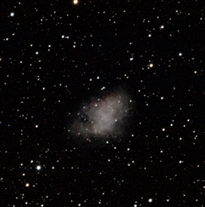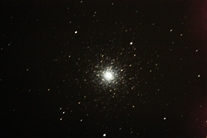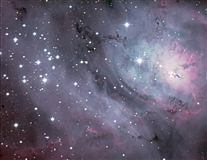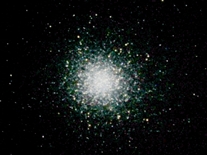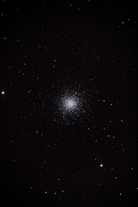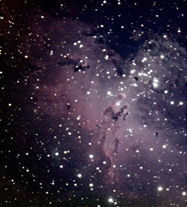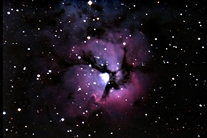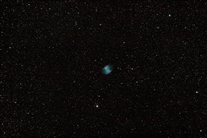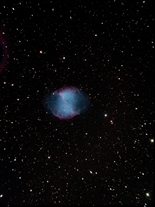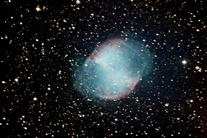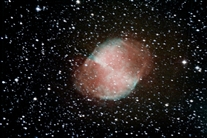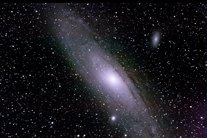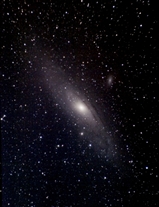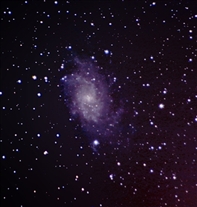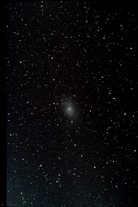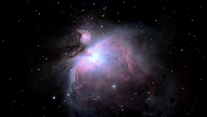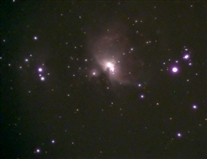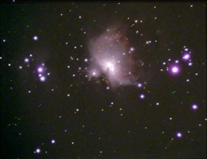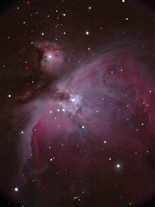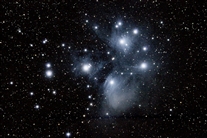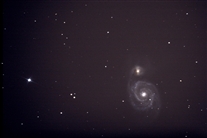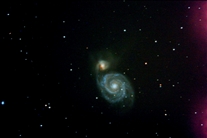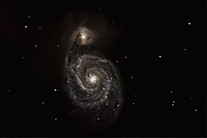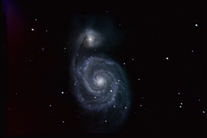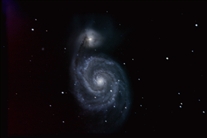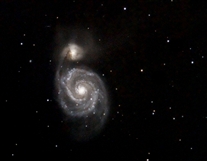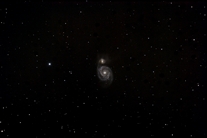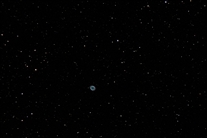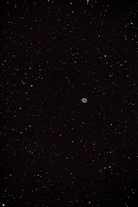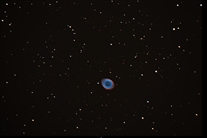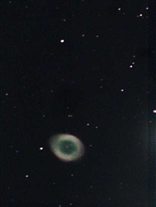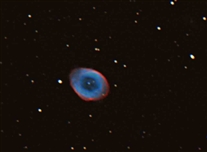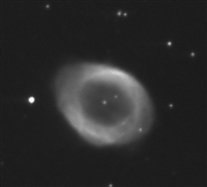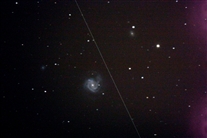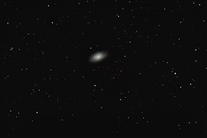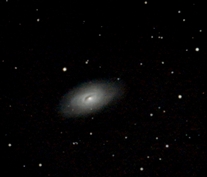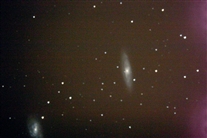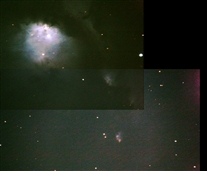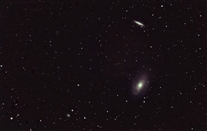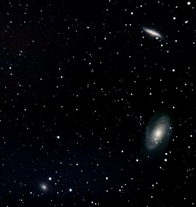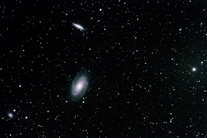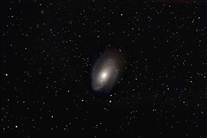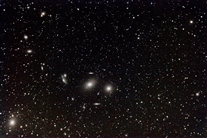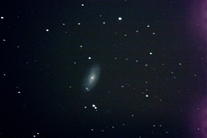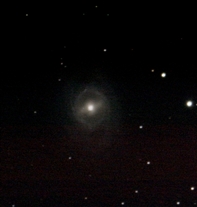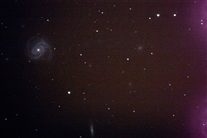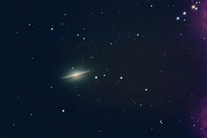m001-crab_45deg_ed80f150_20d-nr_3x1200seciso800_ip-adpadd-ddp2960-crop.jpg
Messier 1 - Crab Nebula, Supernova Remnant M1 (NGC 1952) in Taurus
Image taken with Orion ED80 with 2" Orion Barlow and Canon 20D with internal nose reduction on. It is a stack of 3 images at 20mins each at 800 iso. Images Plus 2.83 adaptive add with DDP at 2960 and cropped to accentuate the nebula.
M1 is a supernova remnant, from a supernova in 1054 AD. Chinese history says that it was so bright that it cast a shadow. It was visible for a long time during the day and for months or years (I forget) at night. For the longest time, it was the brightest object in the sky. This is the first supernova within our galaxy that was recorded in history and witness by humans. The gas clouds continue to move away from the center at a rapid velocity. In addition, I believe the first pulsar was discovered in the center of the crab nebula using radio telescopes.
Right Ascension 05 : 34.5 (h:m)
Declination +22 : 01 (deg:m)
Distance 6.3 (kly)
Visual Brightness 8.4 (mag)
Apparent Dimension 6x4 (arc min)
Discovered 1731 by British amateur astronomer John Bevis.
Excerpt from seds.org:
The Crab Nebula, Messier 1 (M1, NGC 1952), is the most famous and conspicuous known supernova remnant, the expanding cloud of gas created in the explosion of a star as supernova which was observed in the year 1054 AD. It shines as a nebula of magnitude 8.4 near the southern "horn" of Taurus, the Bull.
The supernova was noted on July 4, 1054 A.D. by Chinese astronomers as a new or "guest star," and was about four times brighter than Venus, or about mag -6. According to the records, it was visible in daylight for 23 days, and 653 days to the naked eye in the night sky. It was probably also recorded by Anasazi Indian artists (in present-day Arizona and New Mexico), as findings in Navaho Canyon and White Mesa (both Arizona) as well as in the Chaco Canyon National Park (New Mexico) indicate; there's a review of the research on the Chaco Canyon Anasazi art online. In addition, Ralph R. Robbins of the University of Texas has found Mimbres Indian art from New Mexico, possibly depicting the supernova.
The Supernova 1054 was also assigned the variable star designation CM Tauri. It is one of few historically observed supernovae in our Milky Way Galaxy.
The nebulous remnant was discovered by John Bevis in 1731, who added it to his sky atlas, Uranographia Britannica. Charles Messier independently found it on August 28, 1758, when he was looking for comet Halley on its first predicted return, and first thought it was a comet. Of course, he soon recognized that it had no apparent proper motion, and cataloged it on September 12, 1758. It was the discovery of this object which caused Charles Messier to begin with the compilation of his catalog. It was also the discovery of this object, which closely resembled a comet (1758 De la Nux, C/1758 K1) in his small refracting telescope, which brought him to the idea to search for comets with telescopes (see his note). Messier acknowledged the prior, original discovery by Bevis when he learned of it in a letter of June 10, 1771.
Although Messier's catalog was primarily compiled for preventing confusion of these objects with comets, M1 was again confused with comet Halley on the occasion of that comet's second predicted return in 1835.
This nebula was christened the "Crab Nebula" on the ground of a drawing made by Lord Rosse about 1844. Of the early observers, Messier, Bode and William Herschel correctly remarked that this nebula is not resolvable into stars, but William Herschel thought that it was a stellar system which should be resolvable by larger telescopes. John Herschel and Lord Rosse erroneously thought it is "barely resolvable" into stars. They and others, including Lassell in the 1850s, apparently mistook filamentary structures as indication for resolvability.
Early spectroscopic observations, e.g. by Winlock, revealed the gaseous nature of this object in the later 19th century. The first photo of M1 was obtained in 1892 with a 20-inch telescope. First serious investigations of its spectrum were performed in 1913-15 by Vesto M. Slipher (Slipher 1915, 1916): He found that the spectral emission lines were split. It was later recognised that the true reason for this is Doppler shift, as parts of the nebula are approaching us (thus their lines are blueshifted) and others receding from us (lines redshifted). In 1919, Roscoe Frank Sanford (Sanford 1919) found that the spectrum consists of two major contributions: First, a reddish component which forms a chaotic web of bright filaments, which has an emission line spectrum (including hydrogen lines) like that of diffuse gaseous (or planetary) nebulae, and second a strong blueish diffuse background which has a continuous spectrum.
Heber D. Curtis, in his description of this object based on Lick Observatory photographs, tentatively classified it as a planetary nebula (Curtis 1918), a view which was disproved only in 1933; this mis-classification can still be found in some much newer handbooks.
In 1921, C.O. Lampland of Lowell Observatory, when comparing excellent photographs of the nebula obtained with their 42-inch reflector, found notable motions and changes, also in brightness, of individual components of the nebula, including dramatic changes of some patches near the central pair of stars (Lampland 1921). The same year, J.C. Duncan of Mt. Wilson Observatory compared photographic plates taken 11.5 years apart, and found that the Crab Nebula was expanding at an average of about 0.2" per year; backtracing of this motion showed that this expansion must have begun about 900 years ago (Duncan 1921). Also the same year, Knut Lundmark noted the proximity of the nebula to the 1054 supernova (Lundmark 1921).
In 1942, based on investigations with the 100-inch Hooker telescope on Mt. Wilson, Walter Baade computed a more acurate figure of 760 years age from the expansion, which yields a starting date around 1180 (Baade 1942); later investigations improved this value to about 1140. The actual 1054 occurrance of the supernova shows that the expansion must have been accelerated.
The nebula consists of the material ejected in the supernova explosion, which has been spread over a volume approximately 10 light years in diameter, and is still expanding at the very high velocity of about 1,800 km/sec. The notion of gaseous filaments and a continuum background was photographically confirmed by Walter Baade and Rudolph Minkowski in 1930: The filaments are apparently the remnants from the former outer layers of the former star (the "pre-supernova" or supernova "progenitor"), while the inner, blueish nebula emits continuous light consisting of highly polarised so-called synchrotron radiation, which is emitted by high-energy (fast moving) electrons in a strong magnetic field. This explanation was first proposed by the Soviet astronomer J. Shklovsky (1953) and supported by observations of Jan H. Oort and T. Walraven (1956).
Synchrotron radiation is also apparent in other "explosive" processes in the cosmos, e.g. in the active core of the irregular galaxy M82 and the peculiar jet of giant elliptical galaxy M87. These striking properties of the Crab Nebula in the visible light are equally conspicuous in the Palomar images post-processed by David Malin of the Anglo Australian Observatory, and in Paul Scowen's image obtained on Mt. Palomar.
In 1949, the Crab nebula was identified as a strong source of radio radiation (Bolton et.al. 1949), discovered 1948 named and listed as Taurus A (Bolton 1948), and later as 3C 144. X-rays from this object were detected in April 1963 with a high-altitude rocket of type Aerobee with an X-ray detector developed at the Naval Research Laboratory; the X-ray source was named Taurus X-1. Measurements during lunar occultations of the Crab Nebula on July 5, 1964, and repeated in 1974 and 1975, demonstrated that the X-rays come from a region at least 2 arc minutes in size, and the energy emitted in X-rays by the Crab nebula is about 100 times more than that emitted in the visual light. Nevertheless, even the luminosity of the nebula in the visible light is enormous: At its distance of 6,300 light years (which is quite well-determined, by Virginia Trimble (1973)), its apparent brightness corresponds to an absolute magnitude of about -3.2, or more than 1000 solar luminosities. Its overall luminosity in all spectral ranges was estimated at 100,000 solar luminosities or 5*10^38 erg/s !
On November 9, 1968, a pulsating radio source, the Crab Pulsar (also cataloged as NP0532, "NP" for NRAO Pulsar, or PSR 0531+21), was detected in M1 by astronomers of the Arecibo Observatory 300-meter radio telescope in Puerto Rico. This star is the right (south-western) one of the pair visible near the center of the nebula in our photo. This pulsar was the first one which was also verified in the optical part of the spectrum, when W.J. Cocke, M.J. Disney and D.J. Taylor of Steward Observatory, Tucson, Arizona found it flashing at the same period of 33.085 milliseconds as the radio pulsar with the 90-cm (36-inch) telescope on Kitt peak; this discovery happened on January 15, 1969 at 9:30 pm local time (January 16, 1969, 3:30 UT, according to Simon Mitton). This optical pulsar is sometimes also referred to by the supernova's variable star designation, CM Tauri.
Only in 2007, it came to light that months before the detection of the Crab Pulsar - end even the first pulsar ever discovered - this object had been found in summer 1967, by US Air Force officer Charles Schisler on duty. Charles was on radar duty at Clear USAFB Alaska in summer 1967, when he noticed and logged a fluctuating radio source which was not moving, i.e. at fixed RA and Dec. The next day it was there again, and when he determined its position, he identified it with the Crab Nebula. Subsequently, he found a number of further pulsars. However, USAF decided that this was not their business, and didn't publish his findings. Therefore, Joycelyn Bell independently found her first pulsar a couple of months later.
It has now been established that this pulsar is a rapidly rotating neutron star: It rotates about 30 times per second! This period is very well investigated because the neutron star emits pulses in virtually every part of the electromagnetic spectrum, from a "hot spot" on its surface. The neutron star is an extremely dense object, denser than an atomic nucleus, concentrating more than one solar mass in a volume of 30 kilometers across. Its rotation is slowly decelerating by magnetic interaction with the nebula; this is now a major energy source which makes the nebula shining; as stated above, this energy source is 100,000 times more energetic than our sun.
In the visible light, the pulsar is of 16th apparent magnitude. This means that this very small star is roughly of absolute magnitude +4.5, or about the same luminosity as our sun in the visible part of the spectrum !
Jeff Hester and Paul Scowen have used the Hubble Space Telescope to investigate the Crab Nebula M1 (see also e.g. Sky & Telescope of January, 1995, p. 40). Their continuous investigations with the HST have provided new insight into the dynamic and changes of the Crab nebula and pulsar. More recently, the Heart of the Crab was investigated by HST astronomers.
This object has attracted so much interest that it was remarked that astronomers can be devided into two fractions of about same size: Those who do work related to the Crab nebula, and those who don't. There was a "Crab Nebula Symposium" in Flagstaff, Arizona in June, 1969 (see PASP Vol. 82, May 1970 for results - Burnham). The IAU symposium No. 46, held at Jodrell Bank (England) in August 1970 was solely devoted to this object. Simon Mitton has written a nice book on the Crab Nebula M1 in 1978, which is still most readable and informative (it is also source for some of the informations here).
The Crab Nebula can be found quite easily from Zeta Tauri (or 123 Tauri), the "Southern Horn" of the Bull, a 3rd-magnitude star which can be easily found ENE of Aldebaran (Alpha Tauri). M1 is about 1 deg N and 1 deg W of Zeta, just slightly south and about 1/2 degree west of a mag-6 star, Struve 742.
The nebula can be easily seen under clear dark skies, but can equally easily get lost in the background illumination under less favorable conditions. M1 is just visible as a dim patch in 7x50 or 10x50 binoculars. With a little more magnification, it is seen as a nebulous oval patch, surrounded by haze. In telescopes starting with 4-inch aperture, some detail in its shape becomes apparent, with some suggestion of mottled or streak structure in the inner part of the nebula; John Mallas reports that under excellent conditions, an experienced observer can see them throughout the inner portion of the nebula. The amateur can verify Messier's impression that M1 looks indeed similar to a faint comet without tail in smaller instruments. Only under excellent conditions and with larger telescopes, starting at about 16 inches aperture, suggestions of the filaments and fine structure may become visible.
As the Crab Nebula is situated only 1 1/2 degrees from the ecliptic, there are frequent conjunctions and occasional transits of planets, as well as occultations by the Moon (some of them mentioned above).
M1 is situated in a nice Milky Way field. The star Zeta Tauri is remarkable as it is a Gamma Cassiopeiae type variable, a rather rapidly rotating star of spectral type B4 III pe which has ejected an expanding gas shell, and has a fainter spectroscopic companion star in an orbit of about 133 days period. Preceding M1 two minutes (or half a degree) in Right Ascension is Struve 742 or ADS 4200, another visual binary star with components A (mag 7.2, spectrum F8, of yellow color) and B (mag 7.8, white) separated by about 3.6" in position angle 272deg, and orbiting each other in about 3000 years.
m003_1600iso_300sec_f065_16.jpg
M3 - Globular Cluster. M3 (NGC 5272), class VI, in Canes Venatici
Taken with 12" LX200gps f/10 with Canon 300d - 5 min unguided at Hildebrandt Ranch.
Right Ascension 13 : 42.2 (h:m)
Declination +28 : 23 (deg:m)
Distance 33.9 (kly)
Visual Brightness 6.2 (mag)
Apparent Dimension 18.0 (arc min)
Discovered 1764 by Charles Messier.
Excerpt from seds.org:
Messier 3 (M3, NGC 5272) is one of the most outstanding globular clusters, containing an estimated half million stars. It is famous for the large number of variable stars discovered in it.
This cluster was the first 'original' discovery by Charles Messier when he logged it on May 3rd, 1764. At that time it was the 76th deep sky object ever observed by human eyes (and apparatus), although at that time, it was only the 55th known nebulous object, while 21 objects had been forgotten again, according to the sources and current knowledge of the present author (see the Deep Sky Object Discovery Table). Perhaps the discovery of this object eventually caused Charles Messier to start a systematical search for these comet resembling objects, and not just catalog chance findings as in the previous cases, M1 and M2. Alternatively, Messier may have started this endeavor due to other reasons, and it was just his first discovery - anyway, the search which started with M3 lead him to catalog the objects up to M40 during this year 1764.
When the final object of the catalog, M107, a globular cluster in Ophiuchus, was discovered by Messier's friend Pierre Méchain 18 years later, in 1782, a total of at least 143 objects were known, more than double the number, and 110 of them described by Messier (who discovered 42 or 43) and Méchain (27 or 28) -- the doubty counting being a result of the dubious circumstances concerning the discovery of M102.
M3 was first resolved into stars and recognized as cluster by William Herschel around 1784.
At a distance of about 33,900 light years, M3 is further away than the center of our Galaxy, the Milky Way, but still shines at magnitude 6.2, as its absolute magnitude is about -8.93, corresponding to a luminosity of about 300,000 times that of our sun. M3 is thus visible to the naked eye under very good conditions - and a superb object with the slightest optical aid. Its apparent diameter of 18.0 arc minutes corresponds to a linear extension of about 180 light years; Kenneth Glyn Jones mentions an estimate of even 20 arc minutes from deep photographic plates, corresponding to about 200 light years linear diameter. It appears somewhat smaller in amateur instruments, perhaps about 10 minutes of arc. But its tidal radius, beyond which member stars would be torn away by the tidal gravitational force of the Milky Way Galaxy, is even larger: About 38.19 minutes of arc. Thus, this cluster gravitationally dominates a shperical volume 760 light years in diameter.
On the other hand, M3 has a compressed, dense core measuring 1.1' in diameter, or linearly, 11 light years, comparatively large for a globular. Its half-mass radius is 1.12', or about 11.2 light years, so that half of this clusters mass is contained in a volume of only 22 light years in diameter.
The cluster's brightest stars are of mag 12.7, while the so-called Horizontal Branch giants are of mag 15.7, and the 25 brightest stars have an average brightness of 14.23 mag. The age of globular cluster M3 has been estimated from its color-magnitude diagram on various occasions; historically, early values have been given at 5 billion years (Baade), 11.4 billion years (Woolf), 20 billion years (Arp) and 26 billion years (Sandage). Sandage (1954) counted 44,500 stars brighter than mag 22.5 within a radius of 8 arc min; the total mass has been estimated at 245,000 solar masses (Sandage and Johnson). Helen Sawyer Hogg has given M3's overall spectral type as F2, and a color index -0.05, rather blue for a globular, while the Sky Catalogue 2000.0 gives its spectral type at F7, and W.E. Harris lists it as F6. Its color index was determined as B-V=0.69. This stellar swarm is approaching us at 147.6 km/sec.
Situated in the Galactic halo, out about 40,000 light-years from the Galactic Center, M3 is moving on a box-type orbit of approximate excentricity 0.55, which takes it out up to 66,000 light-years apogalactic distance and up to 49,000 light-years above and below the Galactic plane (currently it is about 33,000 light-years above - i.e., north of - that plane). On the other hand, its perigalactic distance is only 22,000 light-years - at that distance, the tidal radius of M3 will go down to below 200 light-years, so that the outermost stars may easily escape from this globular cluster.
Globular cluster M3 is extremely rich in variable stars: According to B. Madore (in Hanes/Madore, Globular Clusters, 1978), 212 variables have been found, 186 periods determined, more than in every other globular cluster in our Milky Way galaxy (and thus the most ever observed); at least 170 RR Lyrae variables (sometimes called "cluster variables") were discovered. These stars have served as "standard candles" to determine the cluster's distance. The first variable star was discovered by E.C. Pickering in 1889, the next 87 were found by S.I. Bailey in 1895 (see Pickering and Bailey 1895).
M3 contains a relatively large number of so-called Blue Stragglers, blue main-sequence stars which appear to be rather young, much younger than the rest of the globular's stellar population would suggest. These were first discovered by Alan Sandage (1953) on photographic plates taken with the 200-inch Hale telescope on Mt. Palomar. A mystery for a long time, these stars are now thought to have undergone dramatic changes in stellar interactions, getting their cooler outer layers stripped away in close encounters, which occasionally occur when stars are passing through the dense central regions of globular clusters.
To find M3, either prolong the line from Gamma Comae Berenices near the Comae Berenices Cluster over Beta Comae by about 2/3 and look slightly north to have M3 in the low-power field: it is about 6 degrees north-northeast of Beta Comae.
While M3 is visible to the naked eye only under very good conditions and stays just below the limit of visibility under more average conditions, it can be easily seen with the smallest instrument. In binoculars, it appears just like a hazy, nebulous patch. A 4-inch shows its bright compact core within a round and mottled, grainy glow, which fades slowly and uniformly to the outer edges; it doesn't resolve the cluster, but shows just some of the brightest stars under good conditions. A 6-inch resolves the about outer two thirds into faint stars on a background glow formed by the unresolved fainter member stars of the cluster. An 8-inch shows stars throughout the cluster but in the very core, which is resolved into stars by larger telescopes (about 12-inch).
m008_lagoon_avg_200percent_ps-um-lvl.jpg
M8 - Lagoon Nebula, Star forming Nebula. M8 (NGC 6523), an emission nebula, with open star cluster, type "e", in Sagittarius
764mm (30") f/4.8 with Fremont Peak Challenger observatory scope, Canon 20d. Several 2-minute images stacked with Images Plus 2.83.
Right Ascension 18 : 03.8 (h:m)
Declination -24 : 23 (deg:m)
Distance 5.2 (kly)
Visual Brightness 6.0 (mag)
Apparent Dimension 90x40 (arc min)
Discovered by Hodierna about 1654.
Excerpt from seds.org:
The Lagoon Nebula Messier 8 (M8, NGC 6523) is one of the finest and brightest star-forming regions in the sky. It is a giant cloud of interstellar matter which is currently undergoing vivid star formation, and has already formed a considerable cluster of young stars.
This object has been discovered by Giovanni Battista Hodierna before 1654, and classified it as "nebulosa," i.e. of intermediate brightness; it is his No. II.6. It was independently noted as a "nebula" by John Flamsteed about 1680, who cataloged it as his No. 2446. Due to reasons which are not completely clear, at least to the present author [hf], Kenneth Glyn Jones has supposed that Flamsteed may only have seen the cluster within this nebula, a view which we had formerly adopted here. However, Flamsteed's position is close to that later determined by Messier and near the center of the nebula, while the young open cluster, which was later cataloged as NGC 6530, is situated (or at least centered) in the Eastern half of M8.
This object was again seen by Philippe Loys de Chéseaux in 1746, who could resolve some stars and consequently classified it as a cluster. One year later, in 1747, it was observed by Guillaume Le Gentil, who found the nebula together with the cluster. Abbe Nicholas Louis de la Caille has cataloged it in his 1751-52 compilation as Lacaille III.14. When Charles Messier cataloged this object on May 23, 1764, he primarily described the cluster, and mentioned the nebula separately as surrounding the star 9 Sagittarii; his original position is closer to the modern position of the cluster than to that of the nebula. Nevertheless, until recently, most sources identified only the nebula with "Messier 8," a view we reject here: It is clear from Messier's description that he had found both the nebula and the cluster.
William Herschel assigned separate catalog numbers to two objects within, or parts of, the Lagoon Nebula: H V.9 (GC 4363, NGC 6526) and H V.13 (GC 4368, NGC 6533) which are described as large and faint nebulae in the NGC. John Herschel eventually cataloged the open cluster NGC 6530 separately as h 3725 (GC 4366); he has M8 as h 3723 (GC 4361, NGC 6523).
According to Kenneth Glyn Jones, the Lagoon Nebula has an apparent extension of 90x40 minutes of arc, which is 3 x 1 1/3 the apparent diameter of the full moon, and corresponds to about 140x60 light years if our distance of 5,200 light years should be correct, which is a bit uncertain; newer sources have 4850 (Glyn Jones) to 6500, but David J. Eichler gives the value of 5,200 light years (Eichler 1996).
One of the remarkable features of the Lagoon Nebula is the presence of dark nebulae known as 'globules' (Burnham) [see expanded image] which are collapsing protostellar clouds with diameters of about 10,000 AU (Astronomical Units). They can also be seen, along with other detail, in the DSSM image of M8. Some of the more conspicuous globules have been cataloged in E.E. Barnard's catalog of dark nebulae: Barnard 88 (B 88), the comet-shaped globule extended North-to-South (up-down) in the left half and near top of our image, small B 89 in the region of cluster NGC 6530, and long, narrow black B 296 at the south edge of the nebula (lower edge of the image). According to David Eichler, the nebula has probably a depth comparable to its linear extension indicated above.
Within the brightest part of the Lagoon Nebula, a remarkable feature can be seen, which according to its shape is called the "Hourglass Nebula" (see our detailed photos). This feature was discovered by John Herschel and occurs in a region where a vivid star formation process appears to take place currently; the bright emission is caused by heavy excitation of very hot, young stars, the illuminator of the hourglass is the hot star Herschel 36 (mag 9.5, spectral class O7). Closely by this feature is the apparently brightest of the stars associated with the Lagoon Nebula, 9 Sagittarii (mag 5.97, spectral class O5), which surely contributes a lot of the high energy radiation which excites the nebula to shine.
As published in January 1997, the Hubble Space Telescope has been used to study the Hourglass Nebula region in the Lagoon Nebula M8.
The Lagoon Nebula is a magnificient object for the amateur astrophotographer, as Brad Wallis and Robert Provin have demonstrated with their outstanding images, and Dr. Andjelko Glivar with his photos taken through a Celestron 8.
The young open cluster NGC 6530 associated with the Lagoon Nebula M8 was classified as of Trumpler type "II 2 m n" (see e.g. the Sky Catalog 2000), meaning that it is detached but only weakly concentrated toward its center, its stars scatter in a moderate range of brightness, it is moderately rich (50--100 stars), and associated with nebulosity (certainly, with the Lagoon nebula). As the light of its member stars show little reddening by interstellar matter, this cluster is probably situated just in front of the Lagoon Nebula. Its brightest star is a 6.9 mag hot O5 star, and Eichler gives its age as 2 million years. Woldemar Götz mentions this cluster as containing one peculiar Of star, an extremely hot bright star of spectral type O with peculiar spectral lines of ionized Helium and Nitrogen.
The nebula's faint extension to the East (top in our image, but beyond) has an own IC number: IC 4678.
M8 is situated in a very conspicuous field of the Sagittarius Milky Way. Another capture from the DSSM shows the Lagoon Nebula M8 and Trifid Nebula M20, plus the rich star field and faint nebulae surrounding them. We have also more images of the region of M8 and M20, which sometimes also include the nearby open star cluster M21.
m013.hercules_cluster.jpg
M13 - Hercules Cluster
Taken with 304mm (12") f/10.0 LX200GPS, canon 300d, 1x5min 1600iso exposure unguided. This is the first long exposure with the LX200 scope on a Mitty Evolution wedge in polar mode. The object was near the zenith and the tracking was good. But this was the last time I was really ever able to take an unguided 5 minute image in that configuration.
m013_127mmf121_20d-nr_300seciso1600_000002_ip-ddp4122-statdiff1515-addbal_5299-6189_0922.jpg
M13 - Hercules Cluster
A single 5min exposure with in-cam noise reduction at 1600 iso from backyard in the bay area. The scope was a friend's 127mm f/12.1 Orion MakCas sitting atop my AP1200. Nice little scope. The seeing was exceptionaly that night.
m016_adpadd26_ps_umask.jpg
M16 - Eagle Nebula and the Pinnacles of Life (IC 4703, NGC 6611), in Serpens (Cauda)
This was an elusive target for me. I could never really get the pinnacles with the resulution I should have with the 12" SCT. This image was a stack of 26 3min stops at 1600 iso taken at Fremont Peak.
M16 is a Starforming Nebula (IC 4703, NGC 6611), an emission nebula, with Open Star Cluster, type 'e', in Serpens (Cauda)
Right Ascension 18 : 18.8 (h:m)
Declination -13 : 47 (deg:m)
Distance 7.0 (kly)
Visual Brightness 6.4 (mag)
Apparent Dimension 7.0 (arc min)
Excerpt from seds.org:
Cluster M16 (NGC 6611) discovered by Philippe Loys de Chéseaux in 1745-6.
Nebula M16 (IC 4703) discovered by Charles Messier in 1764.
The Eagle Nebula Messier 16 (M16) is a conspicuous region of active star formation, situated in Serpens Cauda. The starforming nebula, a giant cloud of interstellar gas and dust, has already created a considerable cluster of young stars. The cluster is also referred to as NGC 6611, the nebula as IC 4703.
The discoverer, Philippe Loys de Chéseaux, describes only the cluster when recording his 1745-1746 discovery. Charles Messier, on his independent rediscovery of June 3, 1764, mentions that these stars appeared "enmeshed in a faint glow", probably suggestions of the nebula. The Herschels apparently didn't perceive the nebula, so that their catalogs and consequently, the NGC, only describe the cluster. The nebula was added in the IC II of 1908 as IC 4703, with "cluster M16 involved", but the NGC 2000.0 erroneously classifies this object as an open cluster.
The nebula was probably first photographed by E.E. Barnard in 1895, and by Isaac Roberts in 1897; Isaac Robert's finding brought this object into the IC catalog.
Lying some 7,000 light years distant in the constellation Serpens, close to the borders to Scutum and Sagittarius, and in the next inner spiral arm of the Milky Way galaxy from us (the Sagittarius or Sagittarius-Carina Arm) a great cloud of interstellar gas and dust has entered a vivid process of star formation. Open star cluster M16 has formed from this great gaseous and dusty cloud, the diffuse Eagle Nebula IC 4703, which is now caused to shine by emission light, excited by the high-energy radiation of its massive hot, young stars. It is actually still in the process of forming new stars, this formation taking place near the dark "elephant trunks" which are well visible in our photograph, as well as in AAT pictures and other images of M16. A deeper insight in the star formation process could be obtained from the HST images of M16, published in November 1995; moreover, they were used for an animation simulating the approach to this star forming region.
This stellar swarm is only about 5.5 million years old (according to the Sky Catalog 2000 and G├╢tz) with star formation still active in the Eagle Nebula; this results in the presence of very hot young stars of spectral type O6. The cluster was classified as of Trumpler type II,3,m,n (G├╢tz). The brightest star of M16 is of visual magnitude 8.24. At its distance of 7,000 light years, its angular diameter of 7 arc minutes corresponds to a linear extension of about 15 light years. The nebula extends much farther out, to a diameter of over 30', corresponding to a linear size of about 70x55 light years.
Some sources have smaller distances for M16: Kenneth Glyn Jones gives 5,870. G├╢tz 5,540 light years. G├╢tz states that this is one of the intrinsically most luminous open clusters, at an absolute magnitude of -8.21.
M16 is found rather easily, either by locating the star Gamma Scuti, a white giant star of magnitude 4.70 and spectral type A2 III, e.g. from Altair (Alpha Aquilae) via Delta and Lambda Aql; M16 is about 2 1/2 deg (19 min in RA) west of this star. Or, in particular with a pair of binoculars, locate star cloud M24, and move northward via a pair of stars of 6th and 7th mag, followed by small open cluster M18 1deg North of M24, the magnificient Omega Nebula M17 another 1deg N, and finally another 2deg N, M16.
Star cluster M16 and the Eagle Nebula are best seen with low powers in telescopes. A 4-inch reveals about 20 stars in an uneven background of fainter stars and nebulosity; three nebulous concentrations can be glimpsed under good observing conditions. Under very good conditions, suggestions of dark obscuring matter can be seen to the north of the cluster. The Eagle nebula is best seen on photographs, but larger apertures and nebula filters (O-III) may help to trace some detail visually. The dark pillars can be seen in large amateur instruments (12-inch up).
m020_trifidnebulain3d.jpg
M20 - Trifid Nebula, in 3D
If you stare at this image, you get a false sense of 3D. Some stars seem to be up front and some farther away. It is a cheesy experiment but kind of fun in the process.
m020avg4_ps2.c.jpg
M20 - Trifid Nebula (NGC 6514)
Image taken with 764mm (30") f/4.8 FPOA Challenger observatory scope.
The Trifid Nebula gets its name from the three main "petals" in this flower shaped nebula. There are actually four such petals, but only three were visible when it got its name, hense the "tri" part of its name. This nebula has lots of blue reflection nebula component to it, where as the nearby M8 Lagoon Nebula is different.
Messier 20 (NGC 6514) is a Starforming Nebula, an emission and reflection nebula, with Open Star Cluster, in Sagittarius
Right Ascension 18 : 02.6 (h:m)
Declination -23 : 02 (deg:m)
Distance 5.2 (kly)
Visual Brightness 9.0 (mag)
Apparent Dimension 28.0 (arc min)
Discovered by Charles Messier in 1764.
Excerpt from seds.org:
The Trifid Nebula Messier 20 (M20, NGC 6514) in Sagittarius is a remarkable and beautiful object as it consists of both a conspicuous emission nebula and a remarkable reflection nebula component.
Charles Messier discovered this object on June 5, 1764, and described it as a cluster of stars of 8th to 9th magnitude, enveloped in nebulosity, where the remark on nebulosity follows only after the description of nearby M21, and includes that object.
The Trifid Nebula M20 is famous for its three-lobed appearance. This may have caused William Herschel, who normally carefully avoided to number Messier's objects in his catalog, to assign four different numbers to parts of this nebula: H IV.41 (cataloged May 26, 1786) and H V.10, H V.11, H V.12 (dated July 12, 1784). That he numbered this object at all may have its reason in the fact that Messier merely described it as 'Cluster of Stars.' The name 'Trifid' was first used by John Herschel to describe this nebula; this astronomer assigned only one catalog entry to the whole object (h 1991, h 3718, GC 4355) which became J.L.E. Dreyer's NGC 6514.
The dark nebula, which is the reason for the Trifid's appearance, was cataloged by Barnard as Barnard 85 (B 85).
The red emission nebula with its young star cluster near its center is surrounded by a blue reflection nebula which is particularly conspicuous to the northern end. The nebula's distance is rather uncertain, with values between 2,200 light years (Mallas/Kreimer; Glyn Jones has 2,300) and about 7,600 light years (C.R. O'Dell 1963). The Sky Catalog 2000 gives 5,200 light years, a value which is also used by Archinal and Hynes (2003), and which we adopt here. The WEBDA database has 3140, the Hubble Press Release of Jeff Hester (STScI-PRC99-42) gives "about 9000" light years.
As often for nebulae, magnitude estimates spread widely: Kenneth Glyn Jones gives 9.0, while Machholz has estimated 6.8 mag. This may partly come from the fact that the exciting star, HD 196692 or HN 40 or ADS 10991, is a triple system of 7th integrated magnitude (with components A: 7.6, B: 10.7, C: 8.7 mag). All are extremely hot; component A is of spectral type O5 to O7. The Sky Catalogue 2000.0 even lists 4 more, faint components of this "multiple star:" D: 10.7, E: 12.6, F: 14.0, and G: 13.4 mag. This star is located on the west side of the Trifid Nebula cluster. Situated on the northern edge is HD 164514 of visual magnitude 7.42, a supergiant of spectral type A5 Ia. The presence of these considerably bright stars makes brightness estimates for the nebula difficult.
In the sky, the Trifid nebula M20 is situated roughly 2 degrees northwest of the larger Lagoon Nebula M8, so that both nebulae form a nice target for wide field photographs, as these images of the M8 and M20 region, or the big DSSM image of this region. It is even closer to the open cluster M21 and shows up in the upper left edge of our M21 image.
m027_ed80f075_20d-nr_60seciso1600_ip-ddp11416.jpg
M27 - Dumbell Nebula
Orion ED80 f/7.5 with Canon 20D - incamera noise reduction. Single 60sec exposure at 1600iso.
I like the framing and scale of this shot because it shows how the nebula just hangs out there is space and kind of breaks up the darkness with its color and shape. It appears kind of how I imagine it being discovered, though it was most likely discovered visually, which appears black and white.
Right Ascension 18 : 02.6 (h:m)
Declination -23 : 02 (deg:m)
Distance 5.2 (kly)
Visual Brightness 9.0 (mag)
Apparent Dimension 28.0 (arc min)
m027.dumbellneb.combinefilesadpadd.jpg
M27 - Dumbell Nebula
A planetary nebula with a white dwarf star in the center. This is the remnant of a star, much like our sun, that has exhausted its fuel and threw out its contents into space in several last gasps or puffs that expanded out in multiple shells. A 5min exposure reveals at least four such bursts, each tens of thousands of years younger than the next farther one out, where longer exposures reveal even more that are much older.
m027dumbellnebadpadd27_ip-ddh.cropped1024.jpg
M27 - Dumbell Nebula
This was taken with the 764mm f/4.8 Challenger observatory scope. It is a stack of 27 images at about 1-2min each.
Messier 27 - A Planetary Nebula M27 (NGC 6853), type 3a+2, in Vulpecula
Right Ascension 19 : 59.6 (h:m)
Declination +22 : 43 (deg:m)
Distance 1.25 (kly)
Visual Brightness 7.4 (mag)
Apparent Dimension 8.0x5.7 (arc min)
Discovered by Charles Messier in 1764.
Excerpt from seds.org:
The Dumbbell Nebula Messier 27 (M27, NGC 6853) is perhaps the finest planetary nebula in the sky, and was the first planetary nebula ever discovered.
On July 12, 1764, Charles Messier discovered this new and fascinating class of objects, and describes this one as an oval nebula without stars. The name "Dumb-bell" goes back to the description by John Herschel, who also compared it to a "double-headed shot."
We happen to see this one approximately from its equatorial plane (approx. left-to-right in our image); this is similar to our view of another, fainter Messier planetary nebula, M76, which is called the Little Dumbbell. From near one pole, it would probably have the shape of a ring, and perhaps look like we view the Ring Nebula M57.
This planetary nebula is certainly the most impressive object of its kind in the sky, as the angular diameter of the luminous body is nearly 6 arc minutes, with a faint halo extensing out to over 15', half the apparent diameter of the Moon (Millikan 1974). It is also among the brightest, being at most little less luminous with its estimated apparent visual magnitude 7.4 than the brightest, the Helix Nebula NGC 7293 in Aquarius, with 7.3, which however has a much lower surface brightness because of its larger extension (estimates from Stephen Hynes); it is a bit unusual that this planetary is only little fainter photographically (mag 7.6). The present author (hf) was surprized how fine this object was seen in his 10x50 binoculars under moderately good conditions !
As measured by Soviet astronomer O.N. Chudowitchera from Pulkowo (and mentioned by L.H. Aller, Glyn Jones and Vehrenberg), the bright portion of the nebula is apparently expanding at a rate of 6.8 arc seconds per century, leading to an estimated age of 3,000 to 4,000 years, i.e. the shell ejection probably would have been observable this time ago (it actually happened earlier as the light had to travel all the distance of perhaps about 1000 light years). She estimated the distance somewhat short at only about 490 ly. Another estimate, given by Burnham, has obtained a rate 1.0 arc seconds per century, and an estimated age of 48,000 years.
The central star of M27 is quite bright at mag 13.5, and an extremely hot blueish subdwarf dwarf at about 85,000 K (so the spectral type is given as O7 in the Sky Catalog 2000). K.M. Cudworth of the Yerkes Observatory found that it probably has a faint (mag 17) yellow companion at 6.5" in position angle 214 deg (Burnham).
As for most planetary nebulae, the distance of M27 (and thus true dimension and intrinsic luminosity) is not very well known. Hynes gives about 800, Kenneth Glyn Jones 975, Mallas/Kreimer 1250 light years, while other existing estimates reach from 490 to 3500 light years. Currently, investigations with the Hubble Space Telescope are under work to determine a more reliable and acurate value for the distance of the Dumbbell Nebula.
Adopting our value of 1200 light years, the intrinsic luminosity of the gaseous nebula is about 100 times that of the Sun (about -0.5 Mag absolute) while the star is at about +6 (1/3 of the Sun) and the companion at +9..9.5 (nearly 100 times fainter than the Sun), all in the visual light part of the electromagnetic spectrum. That the nebula is so much brighter than the star shows that the star emits primarily highly energetic radiation of the non-visible part of the electro-magnetic spectrum, which is absorbed by exciting the nebula's gas, and re-emitted by the nebula, at last to a good part in the visible light. Actually, as for almost all planetary nebulae, most of the visible light is even emitted in one spectral line only, in the green light at 5007 Angstrom (see our planetary nebula description) !
By comparing images of the Dumbbell Nebula M27, Leos Ondra has discovered a variable star situated in the very outskirts of the nebula which he called Goldilocks' Variable. This variable can be found in some of our images, namely those of Jack Newton, Peter S├╝tterlin and (faintly) David Malin's INT photo, as well as one of the images by John Sefick. Other images such as the one in this page don't show this star, proving its variability.
About 2deg to the West of M27 is inconspicuous open cluster NGC 6830, containing about 20-30 widely scattered stars; this cluster is about 5500 ly distant.
m027dumbellnebadpadd27_ip-ddh-star_ps-huesat.cropped1024.jpg
M27 - Dumbell Nebula
This was taken with the 764mm f/4.8 Challenger observatory scope. It is a stack of 27 images at about 1-2min each.
This is the same as the blueish version, but the hue was rotated in PhotoShop to accentuate some of the nebulostiy.
m031_57deg_ed80f075_20d_800iso_10x300sec_sigmed_ps-lvl-curve-usm.jpg
M31 - The Great Andromeda Galaxy (and M32 and M110)
Taken with Orion ED80 f/7.5, canon 20d, 10x5min 800iso exposures stacked with Images Plus 2.83 (sigma clipped median combine). PhotoShot levels, curves, unsharp mask.
m031_400iso-300mmf5_6_ip-adpadd112x30sec-ddp200-star3_5-hue.jpg
M31 - The Great Andromeda Galaxy. M32 and M110 are also visible in this image.
Orion 300mm f/5.6 Sigma 28-300 zoom lens, canon 20D, 400 iso. 112 x 30sec exposures stacked in Images Plus 2.83. Piggyback on top of LX200GPS in backyard in the bay area.
m033_300mm-f056-400iso-60deg.jpg
M33 - Triangulum Galaxy (NGC 598)
Taken with Sigma 28-300mm zoom lens at 300mm f/5.6, 400iso, 60deg F. Piggyback on LX200
M33 (NGC 598) is a Spiral Galaxy, type Sc, in Triangulum.
Right Ascension 01 : 33.9 (h:m)
Declination +30 : 39 (deg:m)
Distance 3000 (kly)
Visual Brightness 5.7 (mag)
Apparent Dimension 73x45 (arc min)
Probably discovered by Hodierna before 1654. Independently discovered by Charles Messier 1764.
Excerpt from seds.org:
The Triangulum Galaxy Messier 33 (M33, NGC 598) is another prominent member of the Local Group of galaxies. This galaxy is small compared to its big apparent neighbor, the Andromeda galaxy M31, and to our Milky Way galaxy, but by this more of average size for spiral galaxies in the universe. One of the small Local Group member galaxies, LGS 3, is possibly a satellite of M33, which itself may be a remote but gravitationally bound companion of the Andromeda galaxy M31.
M33 is approaching us (our Solar System) at 182 km/s according to R. Brent Tully, or at 179 +/-3 km/s according to NED. Corrected for our motion around the Milky Way's Galactic Center, it is approaching our Galaxy at 24 km/sec.
M33 was probably first found by Hodierna before 1654 (perhaps together with open cluster NGC 752). It was independently rediscovered by Charles Messier, and cataloged by him on August 25, 1764. Nevertheless, William Herschel, who otherwise carefully avoided to number Messier's objects in his survey, assigned it the number H V.17, on the ground of an observation dated September 11, 1784. Also because of the cataloging of Herschel, the brightest and largest HII region (diffuse emission nebula containing ionized hydrogen) has obtained a NGC number of its own: NGC 604 (William Herschel's H III.150); it is situated in the northeastern part of the galaxy; apparently the bright knot near the top of our image. This is one of the largest H II regions known at all: it has a diameter of nearly 1500 light-years, and a spectrum similar to the Orion nebula M42. Hui Yang (University of Illinois) and Jeff J. Hester (Arizona State University) have taken a photograph of NGC 604 with the Hubble Space Tepescope, resolving over 200 young hot massive stars (of 15 to 60 solar masses) which have recently formed here.
M33 was among the first "spiral Nebulae" identified as such by William Parsons, the Third Earl of Rosse; see his drawing. It was also among the first "nebulae" identified as galaxies, in which Cepheid variable stars were found; Edwin Hubble published a fundamental study in 1926 (Hubble 1926).
Several other knots in the spiral arms of M33 have been assigned their own NGC catalog numbers: NGCs 588, 592, 595, and NGC 603 (the latter is listed as nonexistent in the RNGC though, although they mention it was listed by Zwicky), as well as ICs 131, 132, 133, 134, 135, 136, 137, 139-40, 142, and 143 (NGC 2000.0 lists IC 134 and 139-40 as stellar, while the Webb Society Deep-Sky Observer's Handbook, Vol. 4 [Galaxies] shows IC 139-40 on the chart on p. 215, which is credited to Ronald J. Buta of McDonald Observatory, University of Texas). Some of them are identified in our map also. Kenneth Glyn Jones notes that they should be visible in 12.5-inch telescopes. The giant emission nebula NGC 595 was investigated by William H. Waller with the HST (e.g. Astronomy, June 1995, p. 16-18); with Hubble he resolved the hot massive stars that excite that nebula's gas to shine.
Our image, which was obtained by David Malin from photographic plates made with the Isaac Newton Telescope on La Palma, shows many of these objects in the spiral arms of this beautiful Sc spiral (NGC 604, for example, is the prominent red patch near the left edge in the upper half of our photo). Interested readers can obtain more detailed information on this image. By different processing, David Malin has enhanced various features in alternative images from this INT photo of M33.
The results of the Hipparcos satellite have lead to a revision of the cosmic distance scale, therefore also of our distance to M33: The current value is about 3.0 million light-years. Most sources give a distance of 2.3 to 2.4 million light-years, but the Sky Catalogue 2000.0 has more than 2.9 million light-years (900 kpc), which by chance may be closer after the new Cepheid distance recalibration, due to 1997 Hipparcos satellite results. Investigations of Cepheids in M33 of 1991 (Freedman et.al., 1991) have revealed that M33 is at a slightly greater distance from us than the Andromeda Galaxy M31. With our distance values, the distance of M33 from M31 is about 750,000 light-years. Assuming the former value, its angular dimension of 73 arc minutes in major axis (about 2.5 times the Moon's diameter) corresponds to about 50,000 light-years, half the diameter of the Milky Way. However, the faintest outlayers seem to reach more far out, so that the true diameter may be at least 60,000 light-years. The mass of the Triangulum Galaxy has been estimated between 10 and 40 billion solar masses.
The Triangulum galaxy M33 is of type Sc, and even a "late" representative of that type so that Tully classifies it as Scd (in the Nearby Galaxies Catalog). The pronounced arms exhibit numerous reddish HII regions (including NGC 604), as well as blueish clouds of young stars. Baade has also discovered Population II stars, and globular clusters have been found. Although no supernovae have yet been detected in the Triangulum galaxy, several supernova remnants have, and were cartographed by radio astronomers with high acuracy. At least 112 variables have been discovered in M33, including 4 novae and about 25 Cepheids. A strong X-ray source is also situated in this galaxy.
For the observer, this galaxy can be glanced with the naked eye under exceptionally good conditions; for most people, it is the most distant object visible to the naked eye (there are rare reports that some eagle-eyed stargazers managed to see M81 under exceptional conditions, but this is exceptional with all respects). It is outstanding in good binoculars, but as its considerable total brightness is distributed quite evenly over an area of nearly four times that covered by the full Moon, its surface brightness is extremely low. Therefore, it is difficult to impossible to view this galaxy in telescopes which do not allow low magnification - lowest is best for this object ! The best view of M33 the present author had was with a 6-inch refractor at magnification 25. M33 is also a most rewarding target for the astrophotographer, who can track down its spiral arms and brighter nebulae with considerably inexpensive equipment.
More ambitious observers with large telescopes (> 40 cm aperture) may try to track down some of M33's globular clusters; Rich Jakiel has tracked down 5 globular clusters in M33 with a 50-cm telescope.
m033_ip-c_avg19.jpg
M33 - Triangulum Galaxy
This was shot with my 300mm zoom lens. It is 19 exposures stacked.
m042_55_140mmf070_20d-nr_120SecISO800_10xSigMed_ip-crop-ddp2114-astrotools.jpg
M42 - The Great Orion Nebula (in Orion)
Messier 42 is a starforming Nebula (NGC 1976), and an emission and reflection nebula, with Open Star Cluster, in
Right Ascension 05 : 35.4 (h:m)
Declination -05 : 27 (deg:m)
Distance 1.3 (kly)
Visual Brightness 4.0 (mag)
Apparent Dimension 85x60 (arc min)
Image taken from backyard in Pleasanton using TEC140mm f/7.0 scope. The camera was a Canon 20D at 800iso, unmodified, with in-camera noise reduction on. The image is a stack of 10x2min images.
Of the hundreds, to possibly thousands of images I've taken of this object, this is by far the best image. I was surprized even more that it turned out so well because I was imaging from my Mag 3.5 sky in the backyard.
Excerpt from seds.org:
Nebula possibly discovered 1610 by Nicholas-Claude Fabri de Peiresc.
Independently found by Johann Baptist Cysatus in 1611.
Trapezium cluster found as multiple star by Galileo Galilei in 1617.
The Orion Nebula Messier 42 (M42, NGC 1976) is the brightest starforming, and the brightest diffuse nebula in the sky, and also one of the brightest deepsky objects at all. Shining with the brightness of a star of 4th magnitude, it visible to the naked eye under moderately good conditions, and rewarding in telescopes of every size, from the smallest glasses to the greatest Earth-bound observatories as well as outer-space observatories like the Hubble Space Telescope. It is also a big object in the sky, extending to over 1 degree in diameter, thus covering more than four times the area of the Full Moon.
As it is so well visible to the naked eye, one may wonder why its nebulous nature was apparently not documented before the invention of the telescope. Only some Central American, Mayan folk tales may be interpreted in a way suggesting that these native Americans may have known of this nebulous object in the sky (O'Dell 2003, p. 3). However, the brightest stars within the nebula were noted early and cataloged as one bright star of about fifth magnitude: In about 130 AD, Ptolemy included it in his catalog, as did Tycho Brahe in the late 16th century, and Johann Bayer in 1603 - the latter cataloging it as Theta Orion in his Uranometria. In 1610, Galileo detected a number of faint stars when first looking at this region with his telescope, but didn't note the nebula. Some years later, on February 4, 1617, Galileo took a closer look at the main star, Theta1, and found it to be triple, at his magnification of 27 or 28x, again not perceiving the nebula.
The Orion Nebula was probably discovered in late 1610, when Nicholas-Claude Fabri de Peiresc (1580-1637), a French lawyer, turned his telescope to this region of the sky, and reported of a cloudy nebulosity. This sighting, however, was not published, but only reported in Peiresc's personal documents and brought up only by Bigourdan (1916). It was independently found in 1611 by the Jesuit astronomer Johann Baptist Cysatus (1588-1657) of Lucerne who compared it to a comet he had observed in the year 1618 (Cysat 1619). This work also did not get widely known, and opnly turned up by Rudolf Wolf in 1854 (Wolf 1854). The first known drawing of the Orion nebula was created by Giovanni Batista Hodierna, who included three stars; these are probably Theta1 as well as Theta2A and Theta2B. All these discoveries apparently got lost for some time, so that eventually Christian Huygens was longly credited for his independent rediscovery in 1656, e.g. by Edmond Halley who included it in his list of six "nebulae" (Halley 1716), by Jean-Jacques d'Ortous de Mairan in his nebulae descriptions, by Philippe Loys de Chéseaux in his list, by Guillaume Legentil in his review, and by Charles Messier when he added it to his catalog on March 4, 1769.
It is somewhat unusual that the Orion Nebula has found its way into Messier's list, together with the bright star clusters Praesepe M44 and the Pleiades M45; Charles Messier usually only included fainter objects which could be easily taken for comets. But in this one night of March 4, 1769, he determined the positions of these wellknown objects, (to say it with Owen Gingerich) `evidently adding these as "frosting" to bring the list to 45', for its first publication in the Memoires de l'Academie for 1771 (published 1774). One may speculate why he prefered a list of 45 entries over one with 41; a possible reason may be that he wanted to beat Lacaille's 1755 catalog of southern objects, which had 42 entries. Messier measured an extra position for a smaller northeastern portion, reported by Jean-Jacques d'Ortous de Mairan previously in 1731 as a separate nebula, which therefore since has the extra Messier number: M43.
As the drawings of the Orion Nebula known to him did so poorly represent Messier's impression, he created a fine drawing of this Object, in order to "help to recognize it again, provided that it is not subject to change with time" (as Messier states in the introduction to his catalog).
This gorgeous object continued to influence astronomers since. It was the first deepsky observation by William Herschel with a self-constructed reflecting telescope of 6-foot focal length in 1774. In 1789, with some prophetic touch, he described his observations with his 48-inch aperture, 40-foot FL scope as "an unformed fiery mist, the chaotic material of future suns."
The gaseous nature of the Orion Nebula was revealed in 1865 with the help of spectroscopy by William Huggins. On September 30, 1880, M42 was the first nebula to be successfully photographed, by Henry Draper. Consequently, on March 14, 1882, Henry Draper obtained a second, better, deeper, and more detailed photograph of the Orion Nebula, a 137-minutes exposure, which also clearly shows M43.
The Orion Nebula is located at a distance of about 1,600 (or perhaps 1,500) light-years. At this distance, its angular diameter of 66x60 arc minutes corresponds to a linear diameter of about 30 light-years. On its northern end, the nebula is devided by a conspicuous dark lane, well visible in our photograph. This image was obtained David Malin of the Anglo-Australian Observatory. More information on this image is available.
The detached northeastern portion is the nebula M43 first reported by De Mairan, and listed as a separate nebula by Charles Messier. Like the main nebula M42, this is an emission nebula, shining by the light emitted from its atoms, after being excited by the high-energy radiation of massive, very hot young stars within it. In the very neighborhood, to the north, there are also fainter reflection nebulae, partially reflecting the light of the Great Nebula. They were not notable for Charles Messier, but labeled later with the NGC numbers 1973, 1975, and 1977: NGC 1977 had been found by William Herschel (his H V.30), while NGC 1973 and NGC 1975 are discoveries of Heinrich Ludwig d'Arrest. Here we have a collection of more images of M42, M43, and more images of M42, M43 and NGC 1973-5-7.
The Orion Nebula is the brightest and most conspicuous part of a much larger cloud of gas and dust which extends over 10 degrees well over half the constellation Orion. The linear extend of this giant cloud is well several hundreds of light-years. It can be visualized by long exposure photos (see e.g. Burnham) and contains, besides the Orion nebula near its center, the following objects, often famous on their own: Barnard's Loop, the Horsehead Nebula region (also containing NGC 2024 = Orion B), and the reflection nebulae around M78. Already impressive in deep visible light photographs, the Orion Cloud is particularly gorgeous in the infrared light.
M42 itself is apparently a very turbulent cloud of gas and dust, full of interesting details, which Charles Robert O'Dell has compared to the rich topography of the Grand Canyon in his HST photo caption. The major features got names on their own by various observers: The dark nebula forming the lane separating M43 from the main nebula extends well into the latter, forming a feature generally nicknamed the "Fish's Mouth". The bright regions to both sides are called the "wings", while at the end of the Fish's Mouth there's a cluster of newly formed stars, called the "Trapezium cluster". The wing extension to the south on the east (lower left in our image) is called "The Sword", the bright nebulosity below the Trapezium "The Thrust" and the fainter western (right) extension "The Sail". Here we have a small collection of Images of detail in M42, including another nomenclature for the brightest region in the nebula by historic visual observers, as well as a pictorial study of the Trapezium cluster and region by Lowell Observatory images.
The Trapezium Cluster is among the very youngest (open) clusters known, with new stars still forming in this region. As stated above, the cluster was first depicted as triple star on February 4, 1617 by Galileo, who was not aware of the nebula. Galileo's discovery did not get widely known, so that Christian Huygens independently rediscovered the triple star in 1656 together with the Orion Nebula. These first three stars are often labelled "A", "C", and "D". It may be of interest that in both cases, the Trapezium, or Theta1 Orionis, was second to only one other double star: Mizar (Zeta Ursae Majoris). The fourth Trapezium star, "B", was first found by Abbe Jean Picard in 1673 (according to De Mairan), and independently by Huygens in 1684. The fifth cluster star "E" was discovered by Friedrich Georg Wilhelm Struve in 1826 with a 9.5-inch refractor in Dorpat, the sixth, "F", by John Herschel on February 13, 1830, the seventh, "G", by Alvan Clark in 1888 when testing his 36-inch refractor of Lick Observatory, and the eighth, "H" by E.E. Barnard later in 1888 with the same telescope. Barnard later found that "H" is double, with two 16th-magnitude components. Today we know that stars "A" and "B" are both eclipsing variables of Algol type: A (also known as V1016 Ori) was discovered in 1975 to vary between magnitudes 6.73 and 7.53 with a period of 65.4325 days, while B (also cataloged as BM Ori) varies between mag 7.95 and 8.52 in 6.4705 days, and is always the faintest of the four Trapezium stars.
The past decades of research on the Orion Nebula have revealed that the visible nebula, M42, the blister of hot, photo-ionized, luminous gas around hot Trapezium stars, is only a thin layer lying on the surface of a much larger cloud of denser matter, the Orion Molecular Cloud 1 (OMC 1). We happen to see this structure approximately face-on. The idea for this model came originally from Münch (1958) and Wurm (1961) and fully elaborated by several authors around 1973-1974 (Zuckerman (1973), Balick et.al. (1974)), soon supported by evidence, and is still studied in detail, see e.g. O'Dell (2001) for a recent review, and references cited therein. The San Diego Supercomputer Center (SDSC)'s VisLab has created a 3-dimensional visualization of the Orion Nebula based on this model (see side-view model image of M42).
The Orion nebula was, continuously since the early times before its refurbishment, a preferred target for the Hubble Space Telescope. One major discovery was that of protoplanetary disks, the socalled "Proplyds" (planetary systems in formation) in these HST images of M42 (these images were used for an animation simulating the approach to a protostar [caption]). HST images of November 1995 have revealed further insight into the complicated process taking place in this "star factory". Hubble investigations of January 1997 have revealed interesting interactions of the young hot Trapezium cluster stars with the protoplanetary disks: Their violent radiation tends to destruct the discs, so that the lower-mass stars forming here may loose the material needed to form planetary systems.
In 1982, a symposium solely devoted to the Orion Nebula was held to celebrate New York University#s Sesquicentennial, and to honor the one hundredth anniversary of the first photograph of the Orion Nebula taken by Henry Draper on September 30, 1880 (Glassgold et.al. 1982).
An excellent review of the astrophysics of the Orion Nebula is provided in 2003 with the superb monograph by Charles Robert O'Dell (O'Dell 2003), who summarizes the knowledge of that time, including HST research.
It is very easy to find the Orion Nebula, as it surrounds the Theta Orionis multiple star or cluster, seen to the naked eye in the middle of the sword of Orion. Already under fairly good conditions, the nebula itself can be glimpsed with the naked eye as a faint nebulosity around this star.
The Orion Nebula is also one of the easiest and most rewarding target for amateur astrophotographers.
(m042_55_140mmf070_20d-nr_120SecISO800_10xSigMed_ip-crop-ddp2114-astrotools.jpg)
m042_dsi2-1x8.5sec-nodark1_70mmachro-3.3reducer_ps-astroact.jpg
M42 - The Orion Nebula
Taken with Orion Transporter 70mm f/5.0 Achro with 0.33 SAC reducer (takes it to f/1.7) on AP1200 mount unguided. Image is a single 8.5 sec image taken with a DSI2Color that I had just won at a raffle. It was first light for the AP1200 and the DSI2 camera.
The extensive amount of purple hue around the stars is a good example of why you'd want to use an Apochromatic scope instead of an Achromatic scope. The little Transporter f/5.0 scope is really cheap $100 spotting scope with a very short tube. The shortness of the optical path combined with the SAC 0.33 reducer really worsens this effect.
(m042_dsi2-1x8.5sec-nodark1_70mmachro-3.3reducer_ps-astroact.jpg)
m042_dsi2-1x8.5sec_4x6sec_70.jpg
M42 - Orion Nebula
Taken with Orion Transporter 70mm f/5.0 Achro with 0.33 SAC reducer (takes it to f/1.7) on AP1200 mount unguided. Image is a four 6 sec images and one 8.5 sec image taken with a DSI2Color that I had just won at a raffle. It was first light for the AP1200 and the DSI2 camera.
The extensive amount of purple hue around the stars is a good example of why you'd want to use an Apochromatic scope instead of an Achromatic scope. The little Transporter f/5.0 scope is really cheap $100 spotting scope with a very short tube. The shortness of the optical path combined with the SAC 0.33 reducer really worsens this effect.
(m042_dsi2-1x8.5sec_4x6sec_70.jpg)
m042_9x45sec-ed80f075_20d-800iso-nonr-f023_2ndnightap1200gto_firstlight-ed80.jpg
M42 - Orion Nebula complex
First light for my Orion ED80 semiapo. Taken from backyard in the bay area. (2nd light ap1200, first light ed80).
9 x 45 sec, canon 20d, 800iso, no in-camera noise reduction.
(m042_9x45sec-ed80f075_20d-800iso-nonr-f023_2ndnightap1200gto_firstlight-ed80.jpg)
m042___m043_-_orion_nebula_3.jpg
M42 and M43 - Orion Nebula and Running Man Nebula
Image taken by Marko with his Sony F717 digital camera. It is a composite of 30 second images and some shorter images in order to accentuate the Trapezium stars in the center. I think this was taken with his 8" SCT on LXD55 at Shingletown.
m042___m043_-_orion_nebula_5.jpg
M42 and M43 - Orion Nebula and Running Man Nebula
Image taken by Marko with his Sony F717 digital camera. It is a composite of 30 second images and some shorter images in order to accentuate the Trapezium stars in the center. I think this was taken with his 8" SCT on LXD55 at Shingletown.
M045_ed80f075_20d-nr_4x20minSecISO1600_SigMed_ip-ddp2061.jpg
M45 Pleides Cluster (Seven Sisters), in Taurus
| thumbnails/m045_ed80f075_20d-nr_4x20minseciso1600_sigmed_ip-ddp2061.jpg M45 Pleides Cluster (Seven Sisters) (2006) - Dave Samuels
m051_adpadd.ps.jpg M51 - Whirlpool Galaxy - Spiral Galaxy (NGC 5194), type Sc, in Canes Venatici
m051_combinefilesadpadd_dd.jpg m051_combinefilesadpadd_dd.jpg Taken with 304mm (12") LX200gps f/10 ( at f/6.5 with Taurus Tracker III). Image is a single 5min exposure at 1600iso, no darks, no flat. Taken at Hildebrandt Ranch. m051-adpadd16_ps_usm_lvl_spek_.jpg m051-adpadd16_ps_usm_lvl_spek_.jpg (m051-adpadd16_ps_usm_lvl_spek_.jpg) m051_50deg_140mmf070_20d-nr_180SecISO800_23xAddAdd_ip_crop-ddp1691_ps-astrotools_sat_usm_3xSigAvg.jpg m051_50deg_140mmf070_20d-nr_180SecISO800_23xAddAdd_ip_crop-ddp1691_ps-astrotools_sat_usm_3xSigAvg.jpg m051_50deg_140mmf070_20d-nr_180SecISO800_23xAvg_ip-ddp1691.jpg m051_50deg_140mmf070_20d-nr_180SecISO800_23xAvg_ip-ddp1691.jpg m057-ring_60deg_ed80f150_20d-nr_6x20min800iso_ip-adpadd-ddp11416-starsize-statdiff.jpg m057-ring_60deg_ed80f150_20d-nr_6x20min800iso_ip-adpadd-ddp11416-starsize-statdiff.jpg (m057-ring_60deg_ed80f150_20d-nr_6x20min800iso_ip-adpadd-ddp11416-starsize-statdiff.jpg) m057_127mmf121_20d-nr_240seciso1600_000002_ip-ddp4122-statdiff1515-addbal_5299-6189_0922.jpg m057_127mmf121_20d-nr_240seciso1600_000002_ip-ddp4122-statdiff1515-addbal_5299-6189_0922.jpg Enter image description for image (m057_127mmf121_20d-nr_240seciso1600_000002_ip-ddp4122-statdiff1515-addbal_5299-6189_0922.jpg) m057_ddmask.jpg M57 - Ring Nebula
m057ring3_ps.jpg M57 - Ring Nebula (m057ring3_ps.jpg) m057_cr_ddmask_cropped.jpg M57 - Ring Nebula
m057_250mmf100_dsip2_30x15sec_4X_crop.jpg M57 - Planetary Nebula (NGC 6720), type 4+3, in Lyra
m061_1600iso_300sec_f065_17.jpg M061 - Spiral Galaxy (NGC 4303), type SABbc, in Virgo LX200GPS 12" f/6.5 (Tracker3). 5min unguided with Canon 300d at 1600iso. Taken at Hildebrandt Ranch. m064-blackeye_40d_140f070_20d-nr_300SecISO800_ip-ddp2114_32xAdpAdd__ip-ddp26214_ps-astrotools-usm.jpg m064-blackeye_40d_140f070_20d-nr_300SecISO800_ip-ddp2114_32xAdpAdd__ip-ddp26214_ps-astrotools-usm.jpg m064-blackeye_40d_140f070_20d-nr_300SecISO800_ip-ddp2114_32xAdpAdd__ip-crop-ddp26214_ps-astrotools.jpg m064-blackeye_40d_140f070_20d-nr_300SecISO800_ip-ddp2114_32xAdpAdd__ip-crop-ddp26214_ps-astrotools.jpg m066_1600iso_300sec_f065_9.jpg Messier 66 - Spiral Galaxy (NGC 3627), type Sb, in Leo
m066_leotriplet__68deg_ed80f075_20d_9x480seciso1600_sigmed_bdf_ip-ddp2116_pe-despekmed1.jpg m066_leotriplet__68deg_ed80f075_20d_9x480seciso1600_sigmed_bdf_ip-ddp2116_pe-despekmed1.jpg m078_mcneils_mosaic4.jpg m078_mcneils_mosaic4.jpg (m078_mcneils_mosaic4.jpg) m081_ed80-f075-ap1200-unguide_20d-800iso-31x45sec-nr_ip-dark_adpadd_ps_lvl-crv-astroact_2_crop_ip-multires61-40p9-15p7.jpg m081_ed80-f075-ap1200-unguide_20d-800iso-31x45sec-nr_ip-dark_adpadd_ps_lvl-crv-astroact_2_crop_ip-multires61-40p9-15p7.jpg (m081_ed80-f075-ap1200-unguide_20d-800iso-31x45sec-nr_ip-dark_adpadd_ps_lvl-crv-astroact_2_crop_ip-multires61-40p9-15p7.jpg) m081__68deg_ed80f075_20d_13x480seciso1600_adpadd_1_ip_ddp3382_ps-astrotools-lvl.jpg m081__68deg_ed80f075_20d_13x480seciso1600_adpadd_1_ip_ddp3382_ps-astrotools-lvl.jpg (m081__68deg_ed80f075_20d_13x480seciso1600_adpadd_1_ip_ddp3382_ps-astrotools-lvl.jpg) m081_52deg_ed80f075_20d_nr_dark_1x20miniso1600_ps-curve_pe-despekmed1.jpg m081_52deg_ed80f075_20d_nr_dark_1x20miniso1600_ps-curve_pe-despekmed1.jpg (m081_52deg_ed80f075_20d_nr_dark_1x20miniso1600_ps-curve_pe-despekmed1.jpg) m081_45d_140mmf060_20d-nr_300SecISO800_11xSigMed_ip-ddp2114_ps-astrotools_filtered_ninja.jpg m081_45d_140mmf060_20d-nr_300SecISO800_11xSigMed_ip-ddp2114_ps-astrotools_filtered_ninja.jpg
m086-virgo_60deg_ed80f050_20d-nr_1x40miniso1600_ip-flat.jpg m086-virgo_60deg_ed80f050_20d-nr_1x40miniso1600_ip-flat.jpg (m086-virgo_60deg_ed80f050_20d-nr_1x40miniso1600_ip-flat.jpg) m088_1600iso_300sec_f065_12.jpg m088_1600iso_300sec_f065_12.jpg (m088_1600iso_300sec_f065_12.jpg) m095_45deg_ed80f150_20d-nonr_6x20min800iso_med-ddp1200.jpg m095_45deg_ed80f150_20d-nonr_6x20min800iso_med-ddp1200.jpg (m095_45deg_ed80f150_20d-nonr_6x20min800iso_med-ddp1200.jpg) m100_1600iso_300sec_f065_15.jpg m100_1600iso_300sec_f065_15.jpg (m100_1600iso_300sec_f065_15.jpg) m101_63deg_ed80f075_20d-nr_8x20min_sigmed.jpg m101_63deg_ed80f075_20d-nr_8x20min_sigmed.jpg (m101_63deg_ed80f075_20d-nr_8x20min_sigmed.jpg) m104sombrero_1600iso_300sec_f065_11_dd.jpg m104sombrero_1600iso_300sec_f065_11_dd.jpg (m104sombrero_1600iso_300sec_f065_11_dd.jpg) | |||||||||||||||||||||||||||||||||
